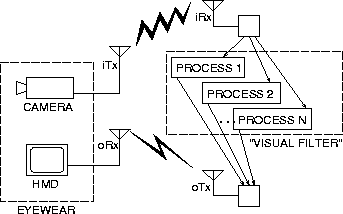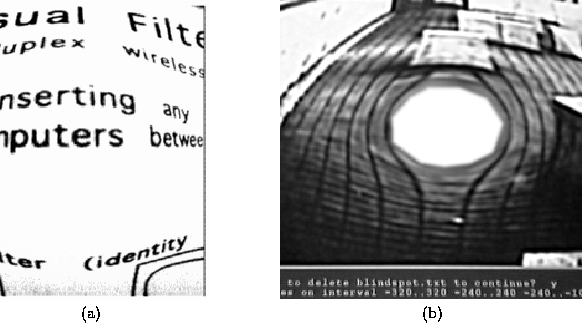


Next: The `visual memory prosthetic'
Up: `Personal Visual Assistant (PVA)'
Previous: PVA Background: Transformation of
The compute-power required to perform general-purpose manipulation of
color video streams was, at the time of the experiments
(1994) too unwieldy to be worn in comfortable clothing
(although
more recently, a clothing-based apparatus has been constructed
to facilitate general-purpose reality mediation without
relying on broadband wireless communications). In particular, a
remotely-located compute-engine
was used by establishing a full-duplex video communications channel
between the wearable apparatus and the host computer(s).
A high-quality communications link (called
the `inbound-channel') was used to
send the video from the camera(s) to the remote computer(s), while a
lower quality communications link (called the `outbound channel') was
used to carry the processed signal from the computer back
to the head-mounted display (HMD). This apparatus is
depicted in Fig 3.
Figure:
Implementation of tetherless
computer-mediated reality
for use as a personal visual assistant.
The camera sends video to one or more more computer systems
over a high-quality microwave communications link,
called the `inbound channel'.
The computer system(s) send back the
processed image over a UHF communications link
called the `outbound channel'.
Note the designations ``i'' for inbound (e.g. iTx
denotes inbound transmitter), and ``o'' for outbound.
The term `visual filter' refers to the process(es)
that mediate(s) the visual reality and optionally insert
virtual objects into the reality stream.
 |
Ideally both channels would be of high-quality, but the
machine-vision algorithms were found to be much more susceptible to noise
than was the wearer's own vision. Originally,
communication was based on antennas that the author
had installed on various rooftops, but presently, the
mediation may also be achieved completely on local (worn) processors.
The apparatus (Fig 2) permitted one to
experience any coordinate transformation that could be expressed
as a mapping from a 2D domain to a 2D range, and the apparatus
could do this in real time (30frames/sec = 60fields/sec) in full color,
because a full-size remote processing engine was used to perform
the coordinate transformations.
This apparatus allowed experiments with various
computationally-generated coordinate
transformations to be performed both indoors and
outdoors, in a variety of different practical situations.
Examples of some useful coordinate transformations
appear in Fig 4.
Figure:
Living in coordinate-transformed worlds:
Color video images are transmitted, coordinate-transformed,
and then received back at 30 frames per second - the full
frame-rate of the VR4 display device.
(a)
This `visual filter' could someday
allow a person with very poor
vision to read (due to the central portion of the visual field
being hyper-foveated for
a very high degree of magnification in this area),
yet still have good peripheral vision
(due to a wide visual field of view arising from demagnified
periphery).
(b) This `visual filter' could some day allow a person with a
scotoma (a blind or
dark spot in the visual field) to see more clearly,
once having learned the mapping.
Note the distortion in the cobblestones on the ground
and the outdoor stone sculptures.
 |
In order for the `personal visual assistant' to be useful, it will need
to be small, lightweight, tetherless, and unobtrusive.
Many of the design issues have already been dealt with, but much remains
to be done.
For example, although the current
body-worn multimedia system has the capability to mediate the
video stream locally,
eye tracking capability built right into the head-mounted
display would greatly advance
the research
toward a system that will hopefully someday
be of widespread benefit to the visually challenged.



Next: The `visual memory prosthetic'
Up: `Personal Visual Assistant (PVA)'
Previous: PVA Background: Transformation of
Steve Mann
1998-09-18


